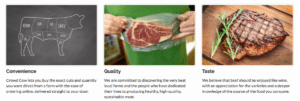Crowd Cow: How One Startup Is Innovating the Food Industry with Crowd-Sourcing

Crowd-sourcing in the food industry? The idea seems preposterous, but a Seattle-based startup is trying to change that. Crowd Cow has created an online platform that allows foodies to purchase various cuts of premium beef with strangers on its website. Customers select the specific cuts of beef, called “shares”, that they would like to purchase and officially become “steakholders” in individual cows. If all parts of an individual cow are purchased by customers, then the transaction works similar to Tilt: the cow is “tipped”, customers are charged for their orders of beef, and the beef is shipped to customers’ homes. Customers are not charged if the cow they bought shares in has not been tipped.
Increased Demand for Premium Beef
The idea for Crowd Cow originally came to co-founders Ethan Lowry and Joe Heitzeberg when they realized that they had foodie friends in Washington who valued grass-fed, dry-aged Wagyu beef so much that they went directly to cattle ranchers to purchase entire steers or heifers. The process was often time-consuming and logistically challenging, however: it took a lot of effort to vet individual cattle ranchers and butchers, transport the beef, and store it safely in large freezers.
Ethan and Joe realized that consumers increasingly want to know where their food is coming from (i.e. rise in popularity of farm-to-table concepts) and to support producers that are ethical and sustainable. They smartly realized there was demand for a premium beef-delivery service that provided consumers with transparency around how the cows were raised and fed and gave them incredible choice over the exact cuts of beef that they could order. And they were right: Crowd Cow has raised over $2 million in VC funding and has made over $1 million in sales since its founding two years ago. In 2017, the company expects to earn revenues of $7-$10 million with its expansion into the East Coast.
Crowd Cow’s Model
Crowd Cow markets its independent cattle ranches to consumers by producing video content that tells stories about the farms (see the below video). These stories bring consumers closer to the farms that they purchase from, satisfying the need for more detailed information around food purchases.
Crowd Cow prices individual cuts of beef anywhere from $12 to $219 (plus a flat shipping fee), and makes sure that their products are less expensive than Whole Foods. The company works with about a dozen independent cattle ranchers to source its meat. The services that Crowd Cow provide make ranchers’ lives a whole lot easier: prior to Crowd Cow’s online platform, individual ranchers would sell beef through public auctions, specialty restaurants, or butchers. Demand was not necessarily predictable, and distribution channels were difficult to manage. Crowd Cow takes on the middlemen responsibilities of marketing, packaging, and shipping products on behalf of the farmers so that they can better focus on raising cattle.
What are the potential growth opportunities for Crowd Cow?
Crowd Cow has thus far favored slower growth and optimizing its supply chain, but there are many potential growth opportunities. With Crowd Cow’s expertise in food logistics and transportation, the company could expand into more geographical regions (such as Canada) and more food categories (such as seafood, poultry, and pork).
What are Crowd Cow’s major challenges?
A crowd-sourced platform for food faces many inherent challenges due to consumers’ preferences. There is certainly demand for many different cuts of premium beef, but some cuts are much more desirable than others. For instance, Crowd Cow has a difficult time selling less popular cuts such as kidneys, liver, tongue, and ground beef. The company must constantly incentivize customers by providing discounts and free shipping on these cuts of beef to ensure that enough cows are tipped on the online platform for customers to come back again and again.
In addition, Crowd Cow’s model suffers from low barriers to entry. Competitors could easily mimic Crowd Cow’s platform and undercut its prices. Currently, a couple of companies (Omaha Steaks and Butcher Box) offer services that are similar to Crowd Cow although they do not utilize its crowd-sourcing model. As Crowd Cow scales up, it will also have to figure out how to economically ship a variety of new products to new regions—it’s possible that logistics become quite expensive and complicated, throwing a wrench into Crowd Cow’s expansion plans.




Great post! I’d imagine that the existing market size of foodies that currently go direct to cattle ranchers to purchase entire steers/heifers is pretty small. I’m speculating, but I’m guessing there is probably a bigger market of buyers that care about where their food comes from, but are able to source locally-produced grass-fed meat from other channels. Do you think Crowd Cow can sell these buyer pain points well enough to ensure steady growth?